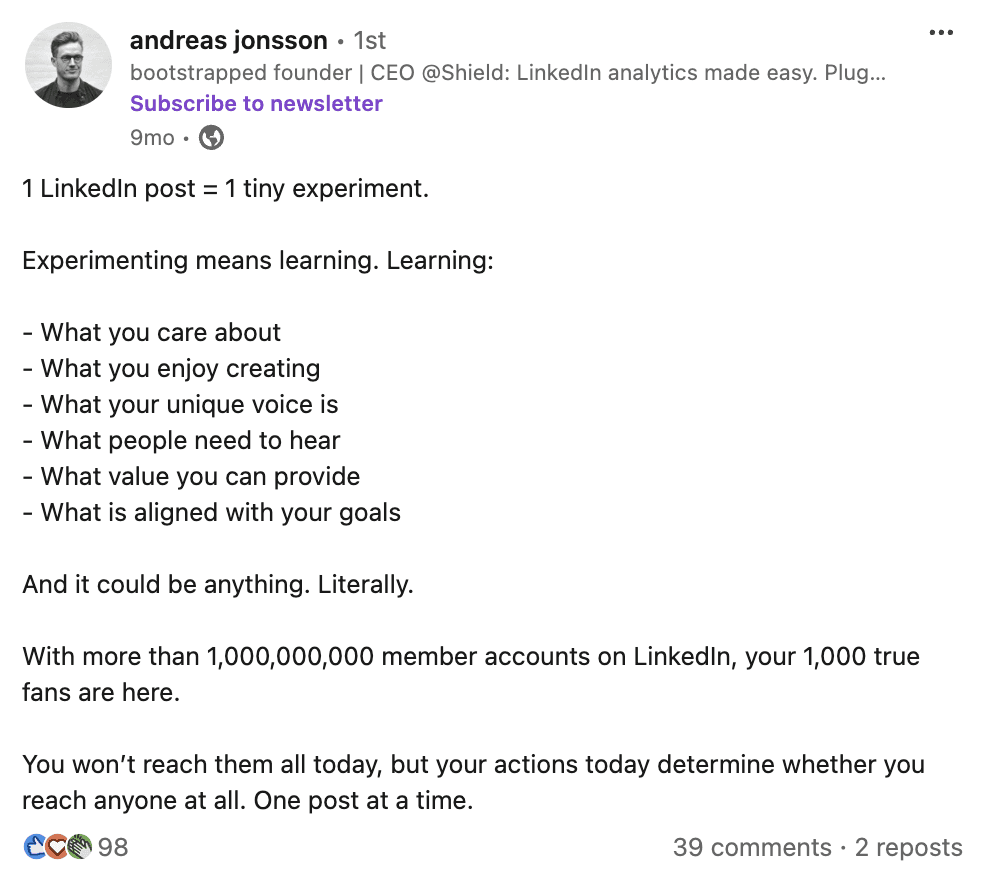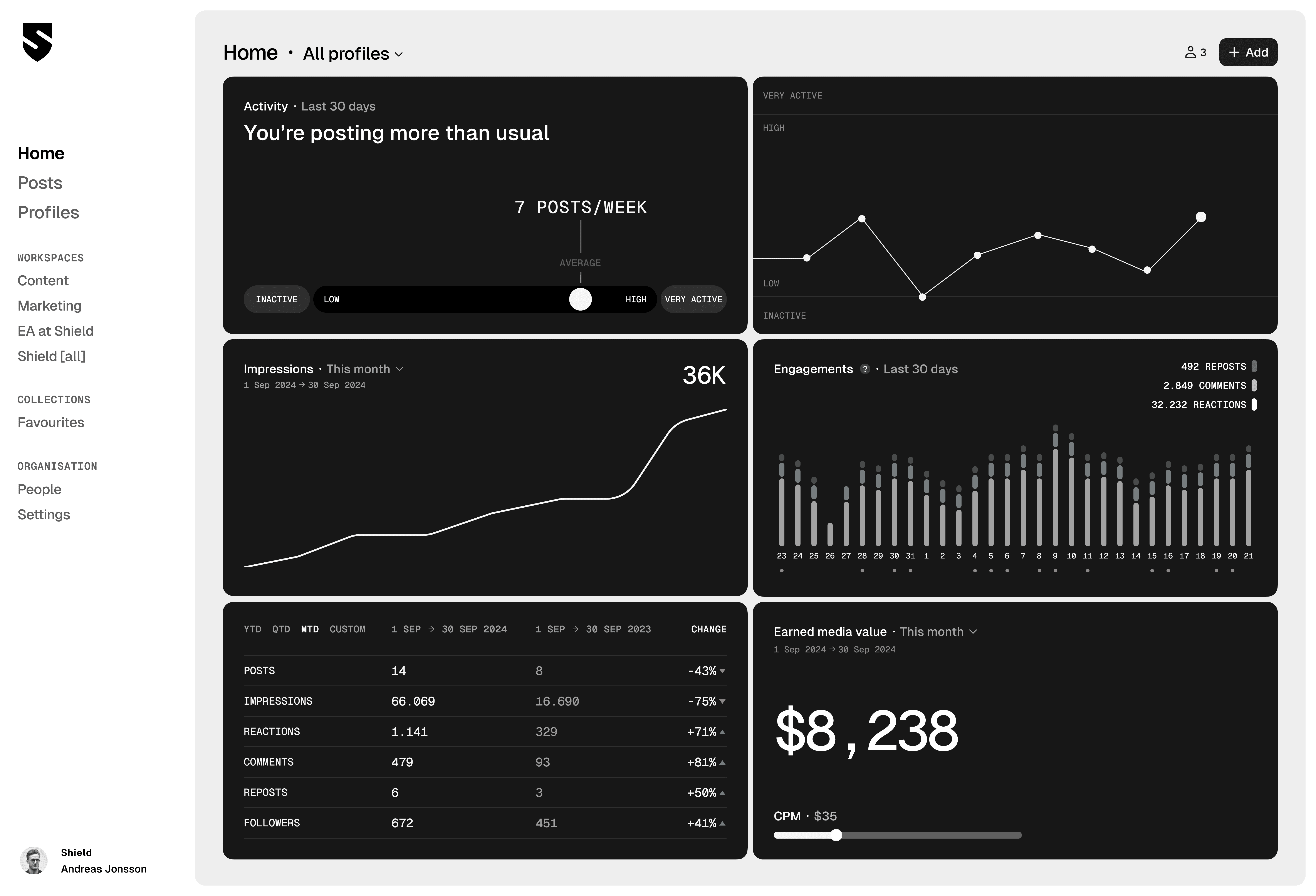How to implement an employee advocacy program




Employee advocacy is a powerful way for companies to extend their reach and strengthen their brand by empowering employees to create and share authentic content. But to get the most out of an employee advocacy initiative, you need a structured approach.
Here’s a step-by-step guide to implementing a successful employee advocacy program that will bring measurable results.
Setting clear goals for your advocacy program

A word of motivation before we start
Define objectives from the start
The first step in launching an employee advocacy program is defining clear objectives.
What are you hoping to achieve?
For many companies, typical goals include increasing brand reach, improving engagement, and enhancing brand credibility through authentic voices. You might also aim to build a stronger sense of community among employees or position your brand as an industry thought leader. Whatever it is, make sure you define it upfront to streamline your efforts from the start.
Align with business goals
An employee advocacy program is most effective when its objectives are aligned with broader business goals. For instance, if your company’s goal is to become a trusted industry leader, employee content could focus on sharing educational insights or thought leadership. When advocacy aligns with business priorities, it’s easier to gain buy-in with leadership and make a real impact.
Establish measurable KPIs
To track the success of your program, define key performance indicators (KPIs) like activity (number of posts), total impressions, engagement rates, follower growth, and potentially website traffic driven by employee posts. Measuring results is crucial for optimizing your program over time and showing stakeholders the value of employee advocacy. Even better, invite key stakeholders (like execs or other leadership teams) to take part in your advocacy efforts. This is by far the most effective way to drive results sooner rather than later. (Top brands across industries and geographies are already doing this, starting from the top of the organization chart.)
Selecting and preparing the first batch of advocates

EGC content from the Shield team
Choose the right employees
Selecting the right people to serve as your initial advocates is essential. Ideal advocates are employees who are enthusiastic about your brand and already active on LinkedIn. Start with a small group of passionate individuals who will set a positive example for others. Usually, these employees will be more than happy to share their learnings and help their colleagues get going.
With Shield, you can organize all your advocates in one workspace, easily track their LinkedIn activity, and gather insights on their engagement metrics.
Encourage voluntary participation
An effective employee advocacy program relies on genuine participation. Employees should feel encouraged but not pressured to create and share content. Voluntary participation ensures that the advocacy is authentic, which audiences will find more credible and engaging. And employees will be most likely to engage and stay consistent in their efforts when they create content they enjoy creating.
Provide training and resources
Not all employees may feel comfortable or know where to start on LinkedIn. Offering training sessions on LinkedIn best practices, brand messaging, and even personal branding can equip and empower employees to represent the company effectively. Share examples of successful posts to inspire new advocates and help them feel confident sharing. Once you get going, you can share examples from within the group of advocates using employee advocacy software like Shield.
Curating and creating shareable content

A post from andreas jonsson that generated 199 reposts
Develop a content strategy
A content strategy is essential to guide what employees create and share. Start by identifying content types that will resonate with your target audience, such as company updates, industry news, employee achievements, and behind-the-scenes glimpses of work culture. Thought leadership content can also position both the company and employees as knowledgeable in their respective fields. With Shield, you can track the performance of different content types shared by employees, identifying what resonates most with audiences. This data-driven approach helps refine your strategy over time, ensuring employees share content that maximizes engagement and reach.
Encourage employee-generated content
While it’s helpful to provide ready-to-share content, encourage employees to create and share their own content as well. When employees post personal reflections or experiences related to their work, it enhances authenticity. And LinkedIn algorithms love authenticity and typically reward such content. Employee-generated content (EGC) often resonates more with audiences than polished corporate posts and should be encouraged once people get started.
Provide content templates
Make sharing easy by offering templates or suggested captions for different types of posts. This ensures the messaging stays consistent with brand values while allowing employees to customize posts with their unique perspective. Templates also help employees get started without feeling pressured to create original content every time. This can be helpful to begin until employees find their own voice and their own strong point of view.
Establishing guidelines and best practices
Promote authenticity
Encourage employees to be authentic in their posts. The goal is not to have employees become corporate mouthpieces but to have them share their unique perspectives and genuine experiences. Authentic content builds trust with the audience, who can see through overly promotional or scripted posts.
Maintain consistency
A consistent posting schedule keeps your employee advocacy program active and visible. Suggest that advocates aim to post once or twice a week. However, flexibility is key—employees should not feel forced to post but should have enough guidance to stay engaged without feeling overwhelmed. In other words, encourage employees to post at a frequency they can sustain over an extended period of time.
Choosing Employee Advocacy software to streamline the process

Key features to look for
Employee advocacy software makes it easy to track, measure and optimize your advocacy program. Look for software that includes key features like metrics tracking, a content library of all published posts, and real-time analytics to make advocacy more accessible and measurable.
Benefits of using software
With employee advocacy software it is easy to track engagement, analyze post performance, and identify which content resonates with your audience. This data-driven approach helps you continuously refine your strategy and demonstrate the program’s impact to stakeholders.
Popular Software Options
Many tools on the market help streamline employee advocacy efforts, including Shield, which provides real-time LinkedIn analytics, a content library of all published posts and more. Investing in the right tool can make a huge difference, helping you maximize your advocacy program's reach and results while saving time on manual tracking.
FAQ on Employee Advocacy program implementation
What content should employees share?
Employees should focus on content that aligns with your company’s brand values and objectives. This could include sharing industry insights, celebrating company achievements, and posting personal reflections on their work experiences.
How often should employees participate?
Encourage employees to post once or twice a week for consistency. This keeps the program active without overwhelming employees or appearing too corporate.
How do I keep employees motivated to participate?
Regularly share the impact of their posts with participants, celebrate successful posts, and recognize employee efforts in advocating for the brand. Highlighting the value of their contributions reinforces the importance of their role in the program.
Conclusion
Implementing an employee advocacy program is a strategic, structured process that requires clear goals, enthusiastic participants, shareable content, and tracking tools like Shield. By empowering employees to share their authentic voices and by supporting them with resources and guidelines, you can amplify your brand’s reach and credibility. Consider using employee advocacy software like Shield, to make managing and measuring your advocacy program easier and more effective.
___
Employee advocacy is a powerful way for companies to extend their reach and strengthen their brand by empowering employees to create and share authentic content. But to get the most out of an employee advocacy initiative, you need a structured approach.
Here’s a step-by-step guide to implementing a successful employee advocacy program that will bring measurable results.
Setting clear goals for your advocacy program

A word of motivation before we start
Define objectives from the start
The first step in launching an employee advocacy program is defining clear objectives.
What are you hoping to achieve?
For many companies, typical goals include increasing brand reach, improving engagement, and enhancing brand credibility through authentic voices. You might also aim to build a stronger sense of community among employees or position your brand as an industry thought leader. Whatever it is, make sure you define it upfront to streamline your efforts from the start.
Align with business goals
An employee advocacy program is most effective when its objectives are aligned with broader business goals. For instance, if your company’s goal is to become a trusted industry leader, employee content could focus on sharing educational insights or thought leadership. When advocacy aligns with business priorities, it’s easier to gain buy-in with leadership and make a real impact.
Establish measurable KPIs
To track the success of your program, define key performance indicators (KPIs) like activity (number of posts), total impressions, engagement rates, follower growth, and potentially website traffic driven by employee posts. Measuring results is crucial for optimizing your program over time and showing stakeholders the value of employee advocacy. Even better, invite key stakeholders (like execs or other leadership teams) to take part in your advocacy efforts. This is by far the most effective way to drive results sooner rather than later. (Top brands across industries and geographies are already doing this, starting from the top of the organization chart.)
Selecting and preparing the first batch of advocates

EGC content from the Shield team
Choose the right employees
Selecting the right people to serve as your initial advocates is essential. Ideal advocates are employees who are enthusiastic about your brand and already active on LinkedIn. Start with a small group of passionate individuals who will set a positive example for others. Usually, these employees will be more than happy to share their learnings and help their colleagues get going.
With Shield, you can organize all your advocates in one workspace, easily track their LinkedIn activity, and gather insights on their engagement metrics.
Encourage voluntary participation
An effective employee advocacy program relies on genuine participation. Employees should feel encouraged but not pressured to create and share content. Voluntary participation ensures that the advocacy is authentic, which audiences will find more credible and engaging. And employees will be most likely to engage and stay consistent in their efforts when they create content they enjoy creating.
Provide training and resources
Not all employees may feel comfortable or know where to start on LinkedIn. Offering training sessions on LinkedIn best practices, brand messaging, and even personal branding can equip and empower employees to represent the company effectively. Share examples of successful posts to inspire new advocates and help them feel confident sharing. Once you get going, you can share examples from within the group of advocates using employee advocacy software like Shield.
Curating and creating shareable content

A post from andreas jonsson that generated 199 reposts
Develop a content strategy
A content strategy is essential to guide what employees create and share. Start by identifying content types that will resonate with your target audience, such as company updates, industry news, employee achievements, and behind-the-scenes glimpses of work culture. Thought leadership content can also position both the company and employees as knowledgeable in their respective fields. With Shield, you can track the performance of different content types shared by employees, identifying what resonates most with audiences. This data-driven approach helps refine your strategy over time, ensuring employees share content that maximizes engagement and reach.
Encourage employee-generated content
While it’s helpful to provide ready-to-share content, encourage employees to create and share their own content as well. When employees post personal reflections or experiences related to their work, it enhances authenticity. And LinkedIn algorithms love authenticity and typically reward such content. Employee-generated content (EGC) often resonates more with audiences than polished corporate posts and should be encouraged once people get started.
Provide content templates
Make sharing easy by offering templates or suggested captions for different types of posts. This ensures the messaging stays consistent with brand values while allowing employees to customize posts with their unique perspective. Templates also help employees get started without feeling pressured to create original content every time. This can be helpful to begin until employees find their own voice and their own strong point of view.
Establishing guidelines and best practices
Promote authenticity
Encourage employees to be authentic in their posts. The goal is not to have employees become corporate mouthpieces but to have them share their unique perspectives and genuine experiences. Authentic content builds trust with the audience, who can see through overly promotional or scripted posts.
Maintain consistency
A consistent posting schedule keeps your employee advocacy program active and visible. Suggest that advocates aim to post once or twice a week. However, flexibility is key—employees should not feel forced to post but should have enough guidance to stay engaged without feeling overwhelmed. In other words, encourage employees to post at a frequency they can sustain over an extended period of time.
Choosing Employee Advocacy software to streamline the process

Key features to look for
Employee advocacy software makes it easy to track, measure and optimize your advocacy program. Look for software that includes key features like metrics tracking, a content library of all published posts, and real-time analytics to make advocacy more accessible and measurable.
Benefits of using software
With employee advocacy software it is easy to track engagement, analyze post performance, and identify which content resonates with your audience. This data-driven approach helps you continuously refine your strategy and demonstrate the program’s impact to stakeholders.
Popular Software Options
Many tools on the market help streamline employee advocacy efforts, including Shield, which provides real-time LinkedIn analytics, a content library of all published posts and more. Investing in the right tool can make a huge difference, helping you maximize your advocacy program's reach and results while saving time on manual tracking.
FAQ on Employee Advocacy program implementation
What content should employees share?
Employees should focus on content that aligns with your company’s brand values and objectives. This could include sharing industry insights, celebrating company achievements, and posting personal reflections on their work experiences.
How often should employees participate?
Encourage employees to post once or twice a week for consistency. This keeps the program active without overwhelming employees or appearing too corporate.
How do I keep employees motivated to participate?
Regularly share the impact of their posts with participants, celebrate successful posts, and recognize employee efforts in advocating for the brand. Highlighting the value of their contributions reinforces the importance of their role in the program.
Conclusion
Implementing an employee advocacy program is a strategic, structured process that requires clear goals, enthusiastic participants, shareable content, and tracking tools like Shield. By empowering employees to share their authentic voices and by supporting them with resources and guidelines, you can amplify your brand’s reach and credibility. Consider using employee advocacy software like Shield, to make managing and measuring your advocacy program easier and more effective.
___
Employee advocacy is a powerful way for companies to extend their reach and strengthen their brand by empowering employees to create and share authentic content. But to get the most out of an employee advocacy initiative, you need a structured approach.
Here’s a step-by-step guide to implementing a successful employee advocacy program that will bring measurable results.
Setting clear goals for your advocacy program

A word of motivation before we start
Define objectives from the start
The first step in launching an employee advocacy program is defining clear objectives.
What are you hoping to achieve?
For many companies, typical goals include increasing brand reach, improving engagement, and enhancing brand credibility through authentic voices. You might also aim to build a stronger sense of community among employees or position your brand as an industry thought leader. Whatever it is, make sure you define it upfront to streamline your efforts from the start.
Align with business goals
An employee advocacy program is most effective when its objectives are aligned with broader business goals. For instance, if your company’s goal is to become a trusted industry leader, employee content could focus on sharing educational insights or thought leadership. When advocacy aligns with business priorities, it’s easier to gain buy-in with leadership and make a real impact.
Establish measurable KPIs
To track the success of your program, define key performance indicators (KPIs) like activity (number of posts), total impressions, engagement rates, follower growth, and potentially website traffic driven by employee posts. Measuring results is crucial for optimizing your program over time and showing stakeholders the value of employee advocacy. Even better, invite key stakeholders (like execs or other leadership teams) to take part in your advocacy efforts. This is by far the most effective way to drive results sooner rather than later. (Top brands across industries and geographies are already doing this, starting from the top of the organization chart.)
Selecting and preparing the first batch of advocates

EGC content from the Shield team
Choose the right employees
Selecting the right people to serve as your initial advocates is essential. Ideal advocates are employees who are enthusiastic about your brand and already active on LinkedIn. Start with a small group of passionate individuals who will set a positive example for others. Usually, these employees will be more than happy to share their learnings and help their colleagues get going.
With Shield, you can organize all your advocates in one workspace, easily track their LinkedIn activity, and gather insights on their engagement metrics.
Encourage voluntary participation
An effective employee advocacy program relies on genuine participation. Employees should feel encouraged but not pressured to create and share content. Voluntary participation ensures that the advocacy is authentic, which audiences will find more credible and engaging. And employees will be most likely to engage and stay consistent in their efforts when they create content they enjoy creating.
Provide training and resources
Not all employees may feel comfortable or know where to start on LinkedIn. Offering training sessions on LinkedIn best practices, brand messaging, and even personal branding can equip and empower employees to represent the company effectively. Share examples of successful posts to inspire new advocates and help them feel confident sharing. Once you get going, you can share examples from within the group of advocates using employee advocacy software like Shield.
Curating and creating shareable content

A post from andreas jonsson that generated 199 reposts
Develop a content strategy
A content strategy is essential to guide what employees create and share. Start by identifying content types that will resonate with your target audience, such as company updates, industry news, employee achievements, and behind-the-scenes glimpses of work culture. Thought leadership content can also position both the company and employees as knowledgeable in their respective fields. With Shield, you can track the performance of different content types shared by employees, identifying what resonates most with audiences. This data-driven approach helps refine your strategy over time, ensuring employees share content that maximizes engagement and reach.
Encourage employee-generated content
While it’s helpful to provide ready-to-share content, encourage employees to create and share their own content as well. When employees post personal reflections or experiences related to their work, it enhances authenticity. And LinkedIn algorithms love authenticity and typically reward such content. Employee-generated content (EGC) often resonates more with audiences than polished corporate posts and should be encouraged once people get started.
Provide content templates
Make sharing easy by offering templates or suggested captions for different types of posts. This ensures the messaging stays consistent with brand values while allowing employees to customize posts with their unique perspective. Templates also help employees get started without feeling pressured to create original content every time. This can be helpful to begin until employees find their own voice and their own strong point of view.
Establishing guidelines and best practices
Promote authenticity
Encourage employees to be authentic in their posts. The goal is not to have employees become corporate mouthpieces but to have them share their unique perspectives and genuine experiences. Authentic content builds trust with the audience, who can see through overly promotional or scripted posts.
Maintain consistency
A consistent posting schedule keeps your employee advocacy program active and visible. Suggest that advocates aim to post once or twice a week. However, flexibility is key—employees should not feel forced to post but should have enough guidance to stay engaged without feeling overwhelmed. In other words, encourage employees to post at a frequency they can sustain over an extended period of time.
Choosing Employee Advocacy software to streamline the process

Key features to look for
Employee advocacy software makes it easy to track, measure and optimize your advocacy program. Look for software that includes key features like metrics tracking, a content library of all published posts, and real-time analytics to make advocacy more accessible and measurable.
Benefits of using software
With employee advocacy software it is easy to track engagement, analyze post performance, and identify which content resonates with your audience. This data-driven approach helps you continuously refine your strategy and demonstrate the program’s impact to stakeholders.
Popular Software Options
Many tools on the market help streamline employee advocacy efforts, including Shield, which provides real-time LinkedIn analytics, a content library of all published posts and more. Investing in the right tool can make a huge difference, helping you maximize your advocacy program's reach and results while saving time on manual tracking.
FAQ on Employee Advocacy program implementation
What content should employees share?
Employees should focus on content that aligns with your company’s brand values and objectives. This could include sharing industry insights, celebrating company achievements, and posting personal reflections on their work experiences.
How often should employees participate?
Encourage employees to post once or twice a week for consistency. This keeps the program active without overwhelming employees or appearing too corporate.
How do I keep employees motivated to participate?
Regularly share the impact of their posts with participants, celebrate successful posts, and recognize employee efforts in advocating for the brand. Highlighting the value of their contributions reinforces the importance of their role in the program.
Conclusion
Implementing an employee advocacy program is a strategic, structured process that requires clear goals, enthusiastic participants, shareable content, and tracking tools like Shield. By empowering employees to share their authentic voices and by supporting them with resources and guidelines, you can amplify your brand’s reach and credibility. Consider using employee advocacy software like Shield, to make managing and measuring your advocacy program easier and more effective.
___
Employee advocacy is a powerful way for companies to extend their reach and strengthen their brand by empowering employees to create and share authentic content. But to get the most out of an employee advocacy initiative, you need a structured approach.
Here’s a step-by-step guide to implementing a successful employee advocacy program that will bring measurable results.
Setting clear goals for your advocacy program

A word of motivation before we start
Define objectives from the start
The first step in launching an employee advocacy program is defining clear objectives.
What are you hoping to achieve?
For many companies, typical goals include increasing brand reach, improving engagement, and enhancing brand credibility through authentic voices. You might also aim to build a stronger sense of community among employees or position your brand as an industry thought leader. Whatever it is, make sure you define it upfront to streamline your efforts from the start.
Align with business goals
An employee advocacy program is most effective when its objectives are aligned with broader business goals. For instance, if your company’s goal is to become a trusted industry leader, employee content could focus on sharing educational insights or thought leadership. When advocacy aligns with business priorities, it’s easier to gain buy-in with leadership and make a real impact.
Establish measurable KPIs
To track the success of your program, define key performance indicators (KPIs) like activity (number of posts), total impressions, engagement rates, follower growth, and potentially website traffic driven by employee posts. Measuring results is crucial for optimizing your program over time and showing stakeholders the value of employee advocacy. Even better, invite key stakeholders (like execs or other leadership teams) to take part in your advocacy efforts. This is by far the most effective way to drive results sooner rather than later. (Top brands across industries and geographies are already doing this, starting from the top of the organization chart.)
Selecting and preparing the first batch of advocates

EGC content from the Shield team
Choose the right employees
Selecting the right people to serve as your initial advocates is essential. Ideal advocates are employees who are enthusiastic about your brand and already active on LinkedIn. Start with a small group of passionate individuals who will set a positive example for others. Usually, these employees will be more than happy to share their learnings and help their colleagues get going.
With Shield, you can organize all your advocates in one workspace, easily track their LinkedIn activity, and gather insights on their engagement metrics.
Encourage voluntary participation
An effective employee advocacy program relies on genuine participation. Employees should feel encouraged but not pressured to create and share content. Voluntary participation ensures that the advocacy is authentic, which audiences will find more credible and engaging. And employees will be most likely to engage and stay consistent in their efforts when they create content they enjoy creating.
Provide training and resources
Not all employees may feel comfortable or know where to start on LinkedIn. Offering training sessions on LinkedIn best practices, brand messaging, and even personal branding can equip and empower employees to represent the company effectively. Share examples of successful posts to inspire new advocates and help them feel confident sharing. Once you get going, you can share examples from within the group of advocates using employee advocacy software like Shield.
Curating and creating shareable content

A post from andreas jonsson that generated 199 reposts
Develop a content strategy
A content strategy is essential to guide what employees create and share. Start by identifying content types that will resonate with your target audience, such as company updates, industry news, employee achievements, and behind-the-scenes glimpses of work culture. Thought leadership content can also position both the company and employees as knowledgeable in their respective fields. With Shield, you can track the performance of different content types shared by employees, identifying what resonates most with audiences. This data-driven approach helps refine your strategy over time, ensuring employees share content that maximizes engagement and reach.
Encourage employee-generated content
While it’s helpful to provide ready-to-share content, encourage employees to create and share their own content as well. When employees post personal reflections or experiences related to their work, it enhances authenticity. And LinkedIn algorithms love authenticity and typically reward such content. Employee-generated content (EGC) often resonates more with audiences than polished corporate posts and should be encouraged once people get started.
Provide content templates
Make sharing easy by offering templates or suggested captions for different types of posts. This ensures the messaging stays consistent with brand values while allowing employees to customize posts with their unique perspective. Templates also help employees get started without feeling pressured to create original content every time. This can be helpful to begin until employees find their own voice and their own strong point of view.
Establishing guidelines and best practices
Promote authenticity
Encourage employees to be authentic in their posts. The goal is not to have employees become corporate mouthpieces but to have them share their unique perspectives and genuine experiences. Authentic content builds trust with the audience, who can see through overly promotional or scripted posts.
Maintain consistency
A consistent posting schedule keeps your employee advocacy program active and visible. Suggest that advocates aim to post once or twice a week. However, flexibility is key—employees should not feel forced to post but should have enough guidance to stay engaged without feeling overwhelmed. In other words, encourage employees to post at a frequency they can sustain over an extended period of time.
Choosing Employee Advocacy software to streamline the process

Key features to look for
Employee advocacy software makes it easy to track, measure and optimize your advocacy program. Look for software that includes key features like metrics tracking, a content library of all published posts, and real-time analytics to make advocacy more accessible and measurable.
Benefits of using software
With employee advocacy software it is easy to track engagement, analyze post performance, and identify which content resonates with your audience. This data-driven approach helps you continuously refine your strategy and demonstrate the program’s impact to stakeholders.
Popular Software Options
Many tools on the market help streamline employee advocacy efforts, including Shield, which provides real-time LinkedIn analytics, a content library of all published posts and more. Investing in the right tool can make a huge difference, helping you maximize your advocacy program's reach and results while saving time on manual tracking.
FAQ on Employee Advocacy program implementation
What content should employees share?
Employees should focus on content that aligns with your company’s brand values and objectives. This could include sharing industry insights, celebrating company achievements, and posting personal reflections on their work experiences.
How often should employees participate?
Encourage employees to post once or twice a week for consistency. This keeps the program active without overwhelming employees or appearing too corporate.
How do I keep employees motivated to participate?
Regularly share the impact of their posts with participants, celebrate successful posts, and recognize employee efforts in advocating for the brand. Highlighting the value of their contributions reinforces the importance of their role in the program.
Conclusion
Implementing an employee advocacy program is a strategic, structured process that requires clear goals, enthusiastic participants, shareable content, and tracking tools like Shield. By empowering employees to share their authentic voices and by supporting them with resources and guidelines, you can amplify your brand’s reach and credibility. Consider using employee advocacy software like Shield, to make managing and measuring your advocacy program easier and more effective.
___


